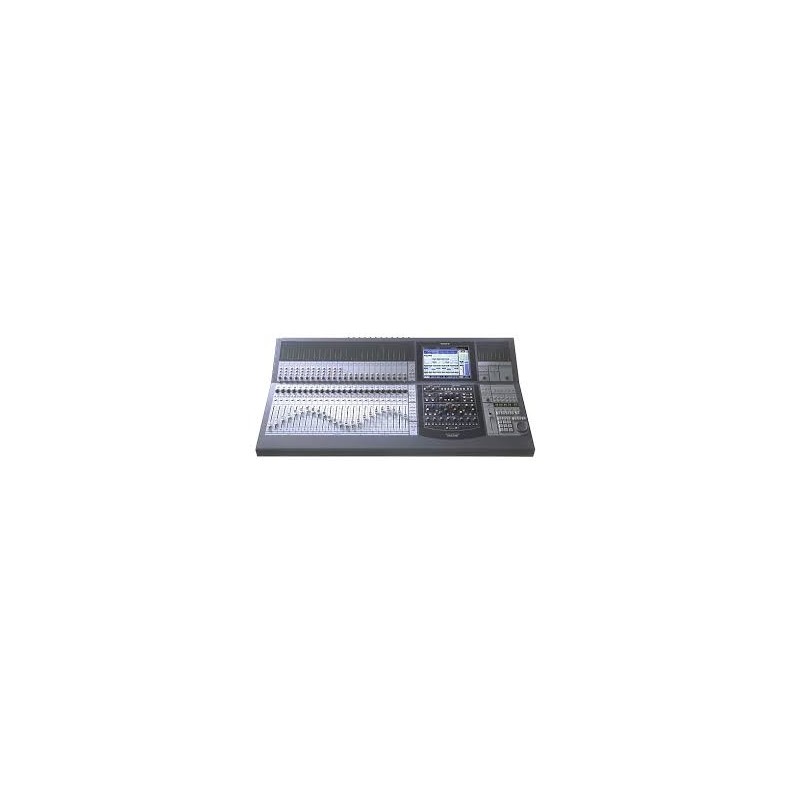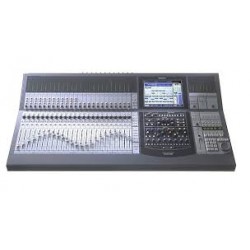



Features
The Sony DMX-R100 is a 48-channel fully automated digital mixing console. The 47.25-inch wide by 10.65-inch high by 27.25-inch deep desk includes 25 motorized faders (with a resolution of 1,024 steps), a built-in monitor that doubles as a control surface, a digital routing matrix and a fully integrated automation package. The 24-bit desk weighs 121.25 pounds and operates at 44.1, 48, 88.2 or 96 kHz.
The desk's performance specs are particularly impressive. The typical Line In to PGM Out frequency response is 20 Hz to 20 kHz +/-0.2 dB with a THD of 0.01 percent at +4 dB, 1 kHz. The typical Mic In to PGM Out is 20 Hz to 20 kHz +/-0.3 dB with a THD of 0.06 percent at -60 dB, 1 kHz. The Line In to PGM Out dynamic range is 104 dB.
The console's rear panel provides an extensive selection of connectors to allow the R100 to adapt to nearly any situation. In addition to these standard connectors, four slots allow for additional I/O options (see below). The R100 has an internal power supply, so a standard IEC power cable connected to 120V AC power and a flip of the power switch (also located on the rear panel) are all that is needed to power-up the desk. The R100's supply doesn't need a cooling fan and there is no internal hard drive - the console is completely quiet.
The R100 has 42 analog inputs. Twelve channels of Analog In A (+24 dBu max, 4.7 k-ohm, balanced, with switchable phantom power) are via standard female XLR connectors. Twelve channels of Analog In B (+24 dBu max, 10 k-ohm, balanced) are via 1/4-inch TRS jacks.
Twelve channels of analog inserts are provided via unbalanced 1/4-inch TRS jacks (tip-send, ring-return). These inserts can be applied to either the Analog In A or the Analog In B inputs and are positioned before the analog to digital converters. Twelve channels of Line In (+24 dBu max, 10 k-ohm, balanced) are provided via combo connectors (accepts either XLR or 1/4-inch connectors). The 2TR In #1's two +4dBu inputs (+24 dBu max, 10 k-ohm, balanced) are provided via two 1/4-inch TRS jacks. Finally, four channels of Aux Return (+24dBu max, 10 k-ohm, balanced) are via 1/4-inch TRS jacks.
The console has 18 analog outputs. Two channels of +4 dBu PGM Out (+24 dBu max, 10 k-ohm load, output impedance 150 ohm, balanced) are via 1/4-inch TRS jacks. Eight of Aux Sends (+24 dBu max, 10 k-ohm load, output impedance 150 ohm, balanced) are provided via 1/4-inch TRS jacks. The Control Room Monitor outputs consist of 6 +4 dBu (+24dBu max, 10 k-ohm load, output impedance 150 ohm, balanced) 1/4-inch TRS jacks.
The desk has six digital inputs and six digital outputs. Four channels of Aux Return are provided via two AES/EBU female XLR connectors and the 2TR In #2's two inputs are via a single AES/EBU female XLR connector. Four channels of aux send are provided via two AES/EBU male XLR connectors and PGM Out is via a single AES/EBU male XLR connector.
Six optional boards provide the R100 with additional I/O. The DMBK-R101 8 CH Analog Line In Board provides eight channels of analog +4 dBu input (maximum input level: +24dBu) via eight female XLR connectors. The DMBK-R102 8 CH Analog Line Out Board provides eight channels of analog +4 dBu output via eight male XLR connectors.
The DMBK-R103 8 CH AES/EBU DIO Board provides eight channels of AES/EBU input via four female XLR connectors and eight channels of AES/EBU output via four male XLR connectors. The DMBK-R104 Sampling Rate Converter DI Board inputs four pairs of digital inputs. Each input can be via an AES/EBU female XLR connector or an optical connector. The DMBK-R105 Insertion Board provides eight unbalanced inserts via eight 1/4-inch TRS jacks. The DMBK-R106 Interface Board for ADAT has two optical connectors. One provides eight channels of lightpipe input and the other, eight channels of lightpipe output. Lastly, the DMBK-R107 Interface Board for TDIF provides eight channels of digital I/O via a 25-pin D-sub connector.
The desk also includes connections for word clock I/O, video sync, time code I/O, MIDI MTC In/Out/Thru, 9-Pin Remote I/O 1/out 2, PC port, foot switch, mouse, keyboard, USB and serial (RS-232C).
Sony is introducing a MADI card for DMX-R100 later this year, which will greatly expand the number of audio channels that can be connected to the mixer. The DMX-R100 MADI card supports 48 input and 48 output channels of audio I/O, providing an ideal method of directly interfacing the DMX-R100 with MADI-capable recorders such as the Sony PCM-3348HR DASH recorder. The MADI card installs in one of the mixer's I/O slots, and all its audio signals can be flexibly routed to DMX-R100 processing channels using the mixer's internal routers.
The desk's control surface is a 21-cm wide by 16-cm high SVGA LCD touchscreen monitor with a resolution of 800 x 600 pixels. The surface allows the user to quickly jump through menus and make adjustments with a constant visual reference to the console's setup or current audio processing. Graphics pages include automation, I/O routing, mixer set up and channel processing. The console has a 15-pin female analog RGB output as well, so an additional monitor offering the same view as the built-in screen can be connected.
The R100's internal audio routing matrix allows any input signal to be routed to any channel or multiple channels. In addition, input signal can be assigned to any output or multiple outputs. Two touch-screen pages control this routing matrix. The first for input signal assignment and the second for output signal assignment. With this flexible routing matrix, the console can be configured to operate like an inline console, a split console or a combination of the two.
The R100's equalizer is four-band parametric with both high-cut and low-cut filters. The high frequency (peak/shelf) is +/-20 dB (128 points, 0.25 dB to 0.5 dB steps) from 622 Hz to 19.9 kHz (61 points) with a Q from 0.5 to 16 (63 points). The high-mid frequency (peak) is +/-20 dB (128 points, 0.25 dB to 0.5 dB steps) from 220 Hz to 7.0 kHz (61 points) with a Q from 0.5 to 16 (63 points).
The low-mid frequency (peak) is +/-20 dB (128 points, 0.25 dB to 0.5 dB steps) from 77.8 Hz to 2.5 kHz (61 points) with a Q from 0.5 to 16 (63 points). The low frequency (peak/shelf) is +/-20 dB (128 points, 0.25 dB to 0.5 dB steps) from 27.5 Hz to 880 Hz (61 points) with a Q from 0.5 to 16 (63 points). The high-cut filter is adjustable from 1.48 kHz to 22.35 kHz (48 points) and the low-cut filter is adjustable from 27.5 Hz to 415 Hz (48 points). Both filters are 12 dB/octave.
The console's dynamics section includes a compressor/ducker and an expander/gate. The compressor/ducker has adjustable threshold, attack time, release time, ratio, range and hold time. The expander/gate also has adjustable threshold, attack time, release time, ratio, range and hold time. Both dynamics functions can be used simultaneously (this is not possible on most small format digital consoles, it is usually one or the other).
When operating at the double-speed sample rates (88.2 and 96 kHz) the number of input channels, direct outs, multitrack busses, bus inserts and aux returns is cut in half. There are only two aux sends (1 and 2), and the maximum channel delay time is cut in half (to 499.9 milliseconds). In addition, the HF band of the channel and bus equalizers extends from 19.9 to 39.8 kHz and the high-cut filter in the channel equalizers extends to 42.2 kHz.